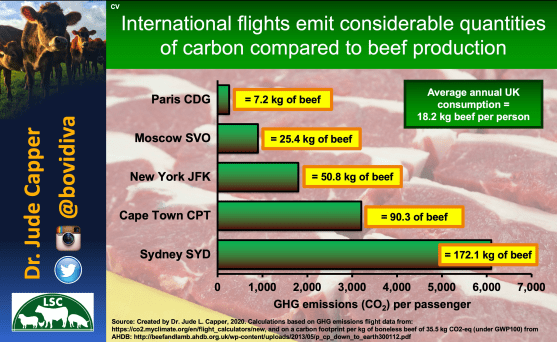
There has been considerable publicity devoted to the announcement that the University of Oxford Student Union Council have voted to approve an on-campus beef and lamb ban. As a university with a truly global population of staff, researchers and students however, it’s worth thinking about the carbon emissions of all the international flights that are associated with the university.
To put these into context:
- The carbon emissions associated with a return flight to Paris = 4.8 months of beef consumption* per passenger.
- The carbon emissions associated with a return flight to JFK = 2.8 years of beef consumption* per passenger.
- The carbon emissions associated with a return flight to Syndey = 9.5 years of beef consumption* per passenger.
Can we assume that banning air travel will be next on the Student Union Council agenda?
*at an average UK consumption of 18.2 kg beef per capita
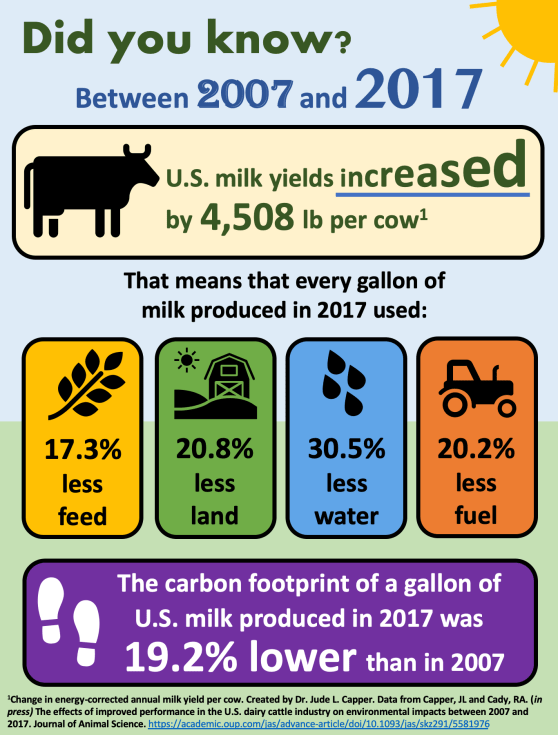
Back in 2009, Prof Dale Bauman, Dr Roger Cady and I published a paper comparing the environmental impacts of the U.S. dairy industry in 1944 to 2007 and showed that through improved productivity, the resource use and carbon footprint per litre of milk decreased considerably over that time.
So what has changed in the past 10 years? I’m excited to announce the publication of our new updated paper in the Journal of Animal Science comparing the environmental impacts of the U.S. dairy industry in 2007 and 2017. Over this decade, milk yield increased by 4,508 lb (2,045 kg) per cow and one gallon (or litre) of milk produced in 2017 required 17.3% less feed, 20.8% less land, 30.5% less water and 20.2% less fuel than that produced in 2007. It’s amazing to see that the carbon footprint has continued to decrease, with a 19.2% decrease per gallon (or litre) of milk between 2007 and 2017. The full paper is available at the journal website here and is open access.
Every congratulations to U.S. dairy farmers for continuing to improve sustainability!
For a high-resolution version of this infographic or any of those below, please feel free to contact me at jude@livestocksustainability.com.
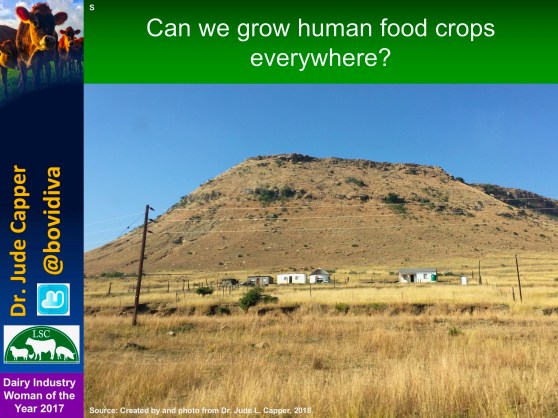 Livestock are a lifeline for many in low-income countries (see latest blog post). I’m pleased to see Prue Leith, Jenny Eclair, Bob Geldof, Jonathan Dimbleby and others lending their support to Send a Cow’s latest campaign – turning #UnheardVoices into powerful messages that need to be heard. Let’s remember livestock’s role in giving hope to those who need it most.
Livestock are a lifeline for many in low-income countries (see latest blog post). I’m pleased to see Prue Leith, Jenny Eclair, Bob Geldof, Jonathan Dimbleby and others lending their support to Send a Cow’s latest campaign – turning #UnheardVoices into powerful messages that need to be heard. Let’s remember livestock’s role in giving hope to those who need it most.
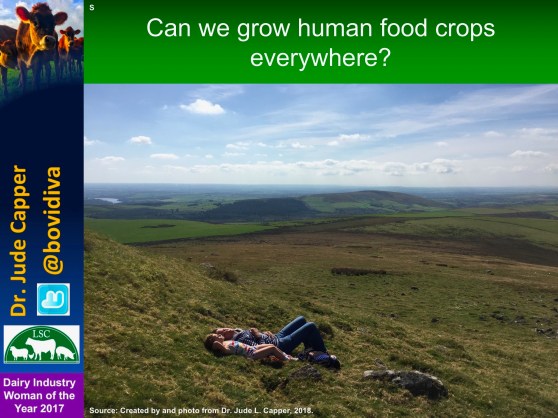 I’m excited to be talking at two #scicomm events this month – the Pint of Science global festival (I’ll be presenting from the White Bear in Bristol tonight – May 15th) and at the Cheltenham Science Festival on June 6th. One of my major themes will be the inconvenient truth that we cannot grow avocados, soy beans or corn on every acre to feed a wholly vegan population – vast areas of the world (from the Welsh hillsides above to the African rural roadside pictured below) will not support human food crop production but can provide grazing for cattle, sheep and goats. Come along if you’re free!
I’m excited to be talking at two #scicomm events this month – the Pint of Science global festival (I’ll be presenting from the White Bear in Bristol tonight – May 15th) and at the Cheltenham Science Festival on June 6th. One of my major themes will be the inconvenient truth that we cannot grow avocados, soy beans or corn on every acre to feed a wholly vegan population – vast areas of the world (from the Welsh hillsides above to the African rural roadside pictured below) will not support human food crop production but can provide grazing for cattle, sheep and goats. Come along if you’re free!

Two weeks ago, I sat in the audience for the Semex conference and heard two different presenters talking about the increasing market for plant-based foods and the myths, mistruths and misconceptions that abound about dairy farming. As a scientist, I know that we need five pieces of positive information to negate every piece of negative information. Lo and behold, #Februdairy was born!

It’s a simple concept, a campaign to celebrate all things that are wonderful about dairy – from cows to cheese, young farmers to yogurt.
So let’s post as many positive dairy tweets (especially those with pics and videos) as we can during February. Facebook and Instagram posts work well too. Anything that you can do to keep the campaign going would be wonderful, even it’s just occasional retweets.
If you’d like to tag your posts using #Februdairy or @Februdairy you can, but please don’t feel you need to. There are some useful guidelines about engaging on social media here, here and here. Feel free to reach out to me too if you would like any more information @Bovidiva.
Unfortunately, there are some rather vile people out there too. Please remember that we all need to support each other and that you can disengage from social media at any time. Don’t ever feel like you are alone in this (or in the industry as a whole) the Farming Community Network and the YANA Project are great resources if any of us need help or someone to talk to.
Together, lets show the world what a wonderful industry we have and celebrate dairy with #Februdairy!
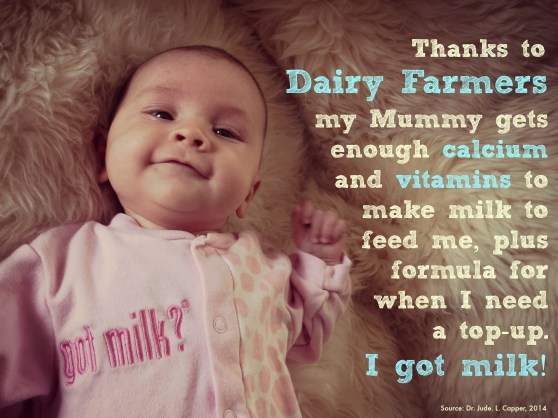 It’s Cow Appreciation Day today – let’s take a moment to remember that dairy cows don’t just produce dairy products for children and adults, but also the majority of formula milks. There’s not doubt that “breast is best” but, for those Mothers unable to produce enough milk (in my case because of cancer treatment), the dairy cow really is the foster mother of the human race.
It’s Cow Appreciation Day today – let’s take a moment to remember that dairy cows don’t just produce dairy products for children and adults, but also the majority of formula milks. There’s not doubt that “breast is best” but, for those Mothers unable to produce enough milk (in my case because of cancer treatment), the dairy cow really is the foster mother of the human race.
 I know that I often spend too much time on Twitter, arguing the merits of animal agriculture with activists or vegans/vegetarians. While we are all unlikely to change people’s deep-seated opinions on dietary choice (indeed, I truly believe that everybody should be free to make their own choices without being preached at), it’s worth remembering that a significant proportion of the population simply want to be reassured that they are choosing food that is safe, affordable and doesn’t have negative consequences for human, animal or ecosystem health. During every frustrating conversation on Twitter or other social media, there are many people seeing the tweets who don’t add to the discussion, but may have their opinions swayed either way – let’s not forget that it’s that the “moveable middle” to whom we are ultimately trying to talk.
I know that I often spend too much time on Twitter, arguing the merits of animal agriculture with activists or vegans/vegetarians. While we are all unlikely to change people’s deep-seated opinions on dietary choice (indeed, I truly believe that everybody should be free to make their own choices without being preached at), it’s worth remembering that a significant proportion of the population simply want to be reassured that they are choosing food that is safe, affordable and doesn’t have negative consequences for human, animal or ecosystem health. During every frustrating conversation on Twitter or other social media, there are many people seeing the tweets who don’t add to the discussion, but may have their opinions swayed either way – let’s not forget that it’s that the “moveable middle” to whom we are ultimately trying to talk.
 It’s often suggested that milk and dairy products contain high levels of hormones that can have undesirable health effects. While it’s true that all foods (with the exception of pure salt and sugar) contain some quantity of hormones, we need to put them into context according to the quantities that we actually consume. According to a peer-reviewed scientific paper available here, bovine milk contains 10 nanograms of oestrogen per litre. By contrast, the contraceptive pill (taken daily by over 100 million women) contains 35,000 nanograms of oestrogen. To equal the same amount of oestrogen as in one pill, the average woman would have to consume 3,500 litres of milk every single day. Even if you bathe in milk (a la Cleopatra), the chances of steroid hormones within the milk altering your body’s metabolism are miniscule.
It’s often suggested that milk and dairy products contain high levels of hormones that can have undesirable health effects. While it’s true that all foods (with the exception of pure salt and sugar) contain some quantity of hormones, we need to put them into context according to the quantities that we actually consume. According to a peer-reviewed scientific paper available here, bovine milk contains 10 nanograms of oestrogen per litre. By contrast, the contraceptive pill (taken daily by over 100 million women) contains 35,000 nanograms of oestrogen. To equal the same amount of oestrogen as in one pill, the average woman would have to consume 3,500 litres of milk every single day. Even if you bathe in milk (a la Cleopatra), the chances of steroid hormones within the milk altering your body’s metabolism are miniscule.
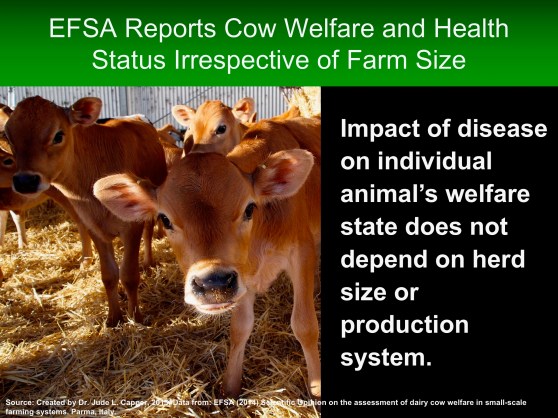 Many activist groups suggest that dairy cow health and welfare is impaired in large herds or specific systems and that the only “happy” cow is one that grazes on grass. There is a place for every single dairy farm, whether small or large, housed or grazed, but we cannot assume that dairy cow welfare is automatically determined by system type. Management is key to cow health and welfare – a well-managed cow will perform better and will have better welfare than a poorly-managed cow, regardless of system.
Many activist groups suggest that dairy cow health and welfare is impaired in large herds or specific systems and that the only “happy” cow is one that grazes on grass. There is a place for every single dairy farm, whether small or large, housed or grazed, but we cannot assume that dairy cow welfare is automatically determined by system type. Management is key to cow health and welfare – a well-managed cow will perform better and will have better welfare than a poorly-managed cow, regardless of system.
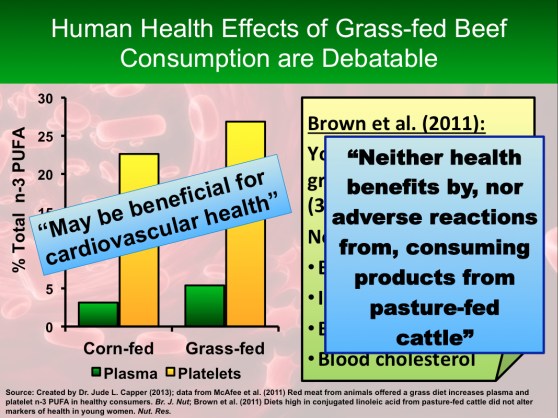
Marketing literature suggesting that a specific system or management practice produces environmentally or nutritionally-superior beef should always be backed by science. Although a number of papers suggest that the increases in omega-3 fatty acids and conjugated linoleic acid in meat and milk from pasture-fed cattle are significant; peer-reviewed research papers (summaries here and here) concluded that these increases do not have biological significance for human health. All meat and dairy products are excellent sources of essential nutrients – let’s celebrate the myriad of sources available rather than trying to mislead the consumer with marketing buzzwords (see latest blog post for more details).
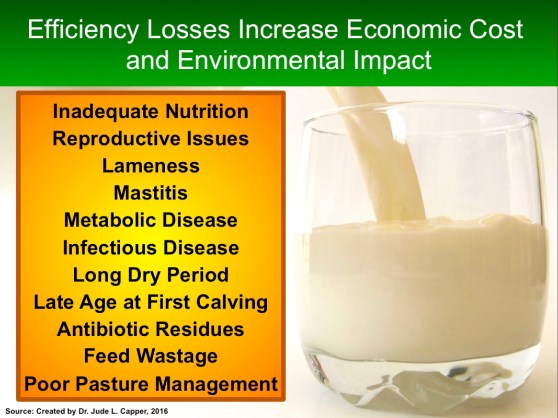 To many consumers, efficiency may be thought of as an undesirable characteristic of modern dairy farms compared to the extensive systems of yesteryear. It’s important to always remember that there is no one-size-fits-all production system or suite of management practices for dairy farms – instead we can make great sustainability gains by improving every facet of dairy efficiency. Efficiency losses mean a greater environmental impact! For more information, see my latest presentation here.
To many consumers, efficiency may be thought of as an undesirable characteristic of modern dairy farms compared to the extensive systems of yesteryear. It’s important to always remember that there is no one-size-fits-all production system or suite of management practices for dairy farms – instead we can make great sustainability gains by improving every facet of dairy efficiency. Efficiency losses mean a greater environmental impact! For more information, see my latest presentation here.
 Refusing the new £5 notes because they contain a trace of tallow? It takes just over half of one cow to produce the tallow required to make all of the UK’s £5 notes – but have you checked your car tyres or beer recently? Both contain some of the myriad by-products that we get from farmed animals. For more information, check out my latest blog post here.
Refusing the new £5 notes because they contain a trace of tallow? It takes just over half of one cow to produce the tallow required to make all of the UK’s £5 notes – but have you checked your car tyres or beer recently? Both contain some of the myriad by-products that we get from farmed animals. For more information, check out my latest blog post here.

Recent articles concentrating on greenhouse gas emissions have suggested that we should choose our food according to carbon footprint – lamb vs. rabbit, lobster vs. butter. However, it’s not that simple. We need to look at the nutrients provided by our food choices and use them to put greenhouse gas emissions into perspective. In this paper, researchers did just that and found that bovine milk had a far better ratio of nutrients (higher numbers are better than lower numbers) to carbon footprint than many plant-based faux milks.

Did you know that the English beef industry has reduced the carbon footprint (per kg of liveweight produced) by 37% since 1970? Cow bodyweight has increased, yet heifer replacement rates have decreased (from 18% to 14%), daily liveweight gain has improved and prime slaughter weights have increased from 477 kg in 1970 to 644 kg in 2010. Productivity isn’t the only factor that matters when assessing carbon footprint, but it has a big impact!
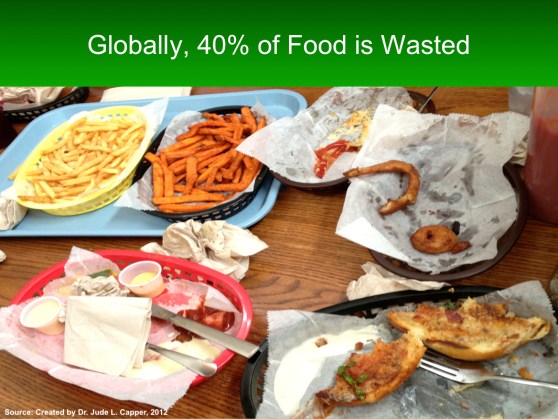
Ironically, when I took this photograph I had been having lunch with some agricultural industry colleagues and we’d both been bemoaning the fact that, globally, 40% of food is wasted. Then we looked down at our lunch table and realised that we were as guilty of this inefficiency as anybody else. If we’re eating out and can’t dictate portion sizes, perhaps it’s time to start sharing or adopting the “doggie bag” approach?

People opposed to intensive farming systems often claim that, as consumers, we don’t want so-called factory-farmed meat and that it has negative consequences for animal, environmental or human health. Indeed, many people who pay a higher (economic) price for alternative meats claim that it tastes better. Yet, does it? A recent study showed that when consumers tasted identical meats labelled “humane” or “factory farmed”, the “humane” labelled meat had consistently higher scores for appearance, smell, taste and enjoyment. A clear case of perception biasing what should be objective reality?

We’re often told that adopting a vegetarian or vegan diet is key to reducing environmental impacts, or that meat should be taxed in order to cut consumption. This week I’m presenting in South Africa – a beautiful country with a thriving dairy industry, but also a significant population of people living in poverty. What are the implications for child nutrition and health if people cannot afford to provide milk and meat for their families?

When Kenyan schoolchildren were supplemented with milk or meat, their academic test scores improved significantly. While we need to be conscious of our consumption patterns, we need to remember that growing children need high-quality protein every single day.

Every single food that we eat has an environmental impact, from apples to zucchini (courgettes). If we make the wholescale decision to cut reduce meat consumption, with what do we replace it, and at what environmental, economic or social cost?
For a high-resolution version of any of these infographics, please feel free to contact me at jude@livestocksustainability.com